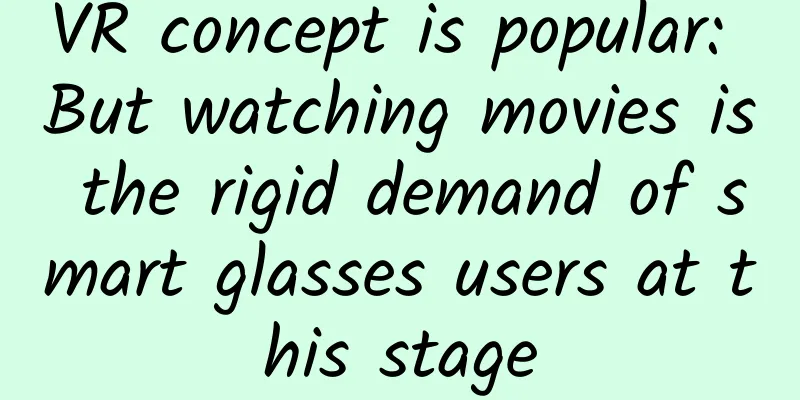VR concept is popular: But watching movies is the rigid demand of smart glasses users at this stage

|
In recent years, the VR and AR industries have become a hot commodity in the eyes of various capitals. Giant companies and entrepreneurs in the fields of film, television, games, and the Internet have all started to deploy VR, and news of high-value financing for VR startups has frequently been reported. Public data shows that 29 VR/AR companies in China received financing last year, and 14 VR/AR companies received financing in March this year alone, of which 12 companies received financing of more than 10 million yuan. This makes the market very volatile, with everyone from giants to entrepreneurs wanting to get a piece of the pie. Smart glasses market chaos: from glasses boxes to head-mounted theaters, all are packaged with VR concepts The popularity of VR has also caused some agitation in the smart video glasses industry. With the involvement of many investors and the pursuit of major media, some smart video glasses manufacturers have begun to worry and have taken advantage of the popularity of VR to attract attention. From glasses boxes to head-mounted theaters, VR glasses, smart video glasses, etc., all claim to be VR. The reason behind this is simple, that is, to make a quick buck by taking advantage of the hot momentum of VR. According to data from relevant industry insiders: There are already hundreds of different forms of VR glasses boxes on the domestic market, with mainstream prices ranging from one hundred to several hundred yuan. In addition, there are many simple VR equipment products that can be made with lenses and cardboard for only 30 yuan flooding the market. The glasses boxes launched by various start-ups are generally priced below 300 yuan. In general, many companies are trying to attract users with low prices, under the pretext of popularizing the user experience cost. However, under this mindset, various "copycat" helmets and crudely made VR glasses, even fake VR glasses and boxes, have begun to increase. In China, there are more than a hundred hardware manufacturers of all sizes. Many companies launch products after just a few months of research and development. Most of them focus on low prices to grab users and markets, but do not reflect technical advantages in product polishing. What are the differences between VR glasses and smart video glasses? The reason why VR glasses and smart video glasses are confused is that many manufacturers want to use the VR concept to win the favor of capital and users, but in fact it is likely to go the other way. We first know that both VR glasses and smart video glasses use head-mounted near-eye display form. Unlike traditional flat-panel displays that present real images, both use magnifying optical systems close to the eyes to form a virtual magnified image in front of the human eye. However, in terms of display screen, VR glasses currently use mobile phone displays, which magnify images through a single-piece magnifying glass, and the graininess is very obvious. Smart video glasses use micro-display screens, which are very fine, and the precision of the magnifying optical system is similar to that of a SLR camera, so the images presented are very clear and fine. The HMZ-T video glasses series launched by Sony between 2011 and 2014 use two micro-displays with a resolution of 1280*720. In November 2015, Nade Optics exhibited the first-generation GOOVIS smart video glasses at the China Hi-Tech Fair, with a single-eye resolution of FHD (1920*1080). Secondly, there is a fundamental difference between smart video glasses and VR glasses in terms of experience. The former emphasizes the ultimate visual presentation and a new viewing experience that is more mobile and has no scene restrictions. VR glasses are mainly computer-generated virtual environments that make the brain believe them to be true. Through the capture of head and body movements, users can interact with the content in an immersive way, and they focus on the interaction and immersion between users and the virtual world. In other words, the 3D technology brought by smart video glasses is one-way, that is, it requires the terminal device to present a three-dimensional visual effect, while the virtual reality scene presented by VR requires human-computer interaction through human-computer interfaces, control devices, etc. If the difference is blurred by using the concept of VR, it will not only cause problems in product positioning such as smart glasses, but also confuse users and cause potential target users to continue to leave. Coupled with the recent rise of the "micro-projection" trend, many users are even more confused. In fact, when the technology and content of the entire industry have not yet reached a mature stage and entrepreneurs' products have no core technological advantages, prematurely attaching the concept of VR to their products will become a burden. The reason is that VR represents future technology, and users have different expectations and requirements for products. It is difficult for them to pay for a VR product with a rough experience; secondly, many mobile phone boxes and glasses products are not VR products in terms of their attributes, but more of a concept created by taking advantage of VR to attract users' attention. Although the VR market is in full swing, there are very few VR products that really provide a good experience. For products such as smart glasses, the core of the mobile movie watching demand is head-mounted 3D display technology. Many manufacturers do not yet have the ability to produce smart video glasses with real 3D cinema-level effects (high definition, high image quality, large screen). They put the concept of VR before the 3D cinema-level effects are ready, but it is difficult to present high-quality VR effects. Many current VR glasses have not solved the portability and mobility of viewing movies, as well as the problems of product dizziness, graininess, delay, etc. Many cheap VR boxes use mobile phone screens, which have serious graininess. Wearing them for a long time will cause dizziness, nausea and other symptoms, causing discomfort to the eyes and body. Many VR glasses manufacturers in the industry have claimed that the delay rate of their products will not exceed 20ms, but the actual experience has not been fundamentally improved. In addition, it is generally recognized in the industry that a 90-degree field of view is required to give viewers an immersive experience, and a 90-degree field of view requires a complete set of optical structure solutions to support it. However, many VR boxes currently do not have good solutions, and even the screen border can be seen in the corner of the eye. Naturally, users are reluctant to pay for such VR products that are only trendy concepts but have a rough experience. To get a good VR experience, you need not only high-performance PC support, but also advanced somatosensory technology support, which is not yet well achieved. In addition, the VR industry is also facing a series of challenges such as insufficient processor capabilities, insufficient display performance, poor interactivity, and lack of content. At present, although the VR market is in full swing, there are very few VR products that really provide a good experience. Therefore, it is not a wise move to use the VR gimmick to promote one's own "mobile cinema" or "smart video glasses". Blindly focusing on the VR concept can easily lead to a decline in user reputation once the product is launched due to many shortcomings and problems in the experience, and the brand is under pressure and sales are difficult to break through the limitations. Do smart glasses entrepreneurs need to distance themselves from the concept of VR? Smart video glasses that do not provide immersion are not suitable for VR under current user demand conditions, because this would make it impossible to accurately position their own product attributes. However, realistic positioning as smart glasses and mobile 3D cinemas would be more sincere and accepted by the public. Only by pragmatically positioning the most direct needs at the moment will users not think that it is a gimmick to make money by using VR. Dr. Peng Huajun, CEO of Shenzhen Nade Optics, believes that most current smart video glasses manufacturers are well aware that positioning their products as "mobile 3D cinemas" (rather than VR glasses) is undoubtedly more easily accepted by users and is consistent with the actual product experience, based on their own technology and the public's clear perception of the cinema experience. On September 13, Nade Optics released GOOVIS-G1, which is positioned as a "mobile 3D cinema". This smart video glasses, like other VR/AR smart glasses, is a near-eye head-mounted display device. The difference is that GOOVIS-G1 uses advanced optical technology and micro display to provide 3D IMAX theater-level viewing experience, simulate 3D theater-level effects (high definition, high image quality, large screen), and is compatible with the massive 2D/3D video resources available on the market. It can be used in aviation, high-speed rail, home, medical, education and training, clubs and other scenarios, focusing on high-quality viewing effects and excellent visual presentation. This is different from some manufacturers in the market who are taking advantage of VR and claiming to be all-in-one VR movie viewing machines. The positioning of GOOVIS-G1 is relatively clear. You should know that Shenzhen Nade Optical Co., Ltd. behind GOOVIS-G1 has been committed to providing near-eye display optical solutions for VR/AR and other smart glasses. When launching the official product GOOVIS-G1, it positioned it as a "real mobile 3D cinema" and deliberately kept a distance from VR. Dr. Peng Huajun explained that currently, the main applications of eyewear products are watching movies and playing games, and users are most concerned about wearing comfort and clear images. Therefore, separating from VR may just hit the rigid needs of smart glasses users - high-definition 3D visual presentation and viewing effects. As mentioned earlier, if the concept of VR is forced, it may lead to the fuzziness of the product concept and the deviation of user needs, which is not conducive to the sales and promotion of the product. Watching movies is the most important demand of smart glasses users at this stage At present, the VR industry is not mature, and the main applications of glasses are watching movies and playing games, while wearing comfort and clear images are the pain points of current users. Nade Optics also saw this and launched the GOOVIS-G1 "mobile 3D cinema" based on the background of powerful optical technology. The technology required for smart video glasses to create excellent image quality and highlight cinema-level visual effects has matured, and the required optics, structure, electronic drive, image processing and other technologies have reached a relatively high level, which can fully meet the users' private mobile viewing needs. It is better to take the mobile 3D route than to mechanically apply a VR concept. However, many VR glasses cannot achieve the effects that users want in terms of technology and experience. In the current impetuous environment, Nade Optics focuses on users' rigid needs for watching movies and playing games. Combined with its own optical display technology background and product performance, it can better highlight the differentiated and outstanding comprehensive experience and can also more easily open up the market quickly. It is foreseeable that it will take some time for VR to really explode. In the smartphone market, Apple iOS and Android opened up the smartphone market by building a content ecosystem. In the field of VR glasses, content is still king. The popularity of VR glasses also depends on the support of rich and colorful content. In the future, VR glasses and smart video glasses may be integrated, but the basis for their integration will be the continuous formation of rich and colorful VR content and the continuous improvement of head-mounted display and interactive perception technology. 3D emphasizes the three-dimensional sense of vision, while VR emphasizes the immersive sense of vision and gameplay. VR needs more convincing 3D effects and technology and immersive experience. VR/AR technology is an extension of 3D technology. In the future, VR glasses may gradually evolve from the current smart glasses. In other words, 3D technology will gradually extend to the VR field, which is the future development direction. But for now, it will take time to build and enrich VR content and mature the technology and establish industry standards at all ends of the industry chain. VR software architecture, content platform, profit model, etc. are still in the exploratory stage. VR has become an essential element for many entrepreneurs to tell a good story and has led to a capital boom, but it is clear that the time is not yet ripe. This wave of VR entrepreneurship will soon pass. Manufacturers that focus on VR concepts but lack core technologies may face a reshuffle, and the crisis of VR entrepreneurs has just begun. |
<<: Should you upgrade your iPhone to iOS 10?
Recommend
Can WeChat’s paid reading function allow content creators to live a good life?
It has been rumored for a long time that WeChat w...
Bai Juyi and Du Fu were also nearsighted! Without glasses, what would the ancients do if they were nearsighted?
Planning and production Source: Minitory (ID: min...
Baise Game Mini Program Customization Price Inquiry, How much does it cost to customize the Baise Game Mini Program?
There are two types of customization of Baise Gam...
YOGA Goddess Training Camp-Slimming Yoga Class
Course catalog: Lesson 01: If you don’t breathe co...
Lao You's short-term system: the essence of the short-term system and the leading strategy
Lao You’s short-term system: The essence of the sh...
MediaTek financial report: Dimensity flagship chip revenue increased 100% year-on-year to US$2 billion in Q4 2024
According to recent news, chip giant MediaTek rec...
Entry-level products are awesome! Tencent invests $1 billion in Meituan Dianping
[[154656]] There are really big news on the Chine...
Learn how to place Zhihu information flow ads in one article!
Today I decided to use this article to talk about...
Yangjiang mini program development company, which company should I look for for WeChat mini program development?
Yangjiang mini program development company, which...
Liu Xiaohu's five steps to build a beautiful buttocks with Pilates and Victoria's Secret
Liu Xiaohu's five-step Pilates Victoria's...
Urban Beauty brand event promotion case analysis!
Recently, Lin Chiling, the spokesperson for the w...
New Year's tips for beginners in programming
[[161291]] 1. When will I be able to finish learn...
The first comprehensive lunar geological map is released
According to the Physicists' Organization web...
9 content marketing tips to help you create killer copywriting!
This article is 2500 words long and is recommende...
For a sprained joint, should you apply heat or cold?
In daily life, various joint sprains are common, ...









